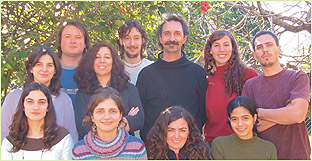|
SANITARY AND FEEDING APIARY HANDLING
Ricardo Miguel Prieto
prieto@infovia.com.ar
- Junín - Buenos Aires - Argentina

Ricardo Jr. adding bees to reinforce nucleus quickly.
We publish the main lines of sanitary and nutritous apiary handling that Ricardo Prieto presented in the "Fair and Beekeeping Meeting from the Center of the Country", last May in San Francisco city.
It is an excellent complement to a Beekeeping initiation course.
The presentation comes together with the effort that this recognized queen bee breeder makes to systematize the apiary handling through his program
"Api-breeding” and the fair valuation of the factors that condition the productivity.
The characteristic of his analysis is that the productivity is the indicator of the scale from which others factors or variables must be taken into account. In general who start beekeeping from an academic formation, usually tend to value the productivity from just a simple variable, privileging its influence, in front of a wider vision characteristic of a experienced beekeeper.
The topics developed by Ricardo in this extensive synthesis were accompanied by its illustrations and graphics. Subtitles sometimes make reference to specific topics and others to practical recommendations that make indispensable turn to the text to understand those recommendations:
- APIARY UNIFORMITY
- AVOIDING THE DRIFT
- ADDING BEE NOT BREED
- POPULATIONAL AND SANITARY BALANCE
- DETERMINATION OF THE POPULATIONAL BALANCE
- VARROA
- European and American foulbrood
- ANTIBIOTIC MANAGEMENT
- SANITARY WITHOUT ANTIBIOTICS
- QUEENS REPLACEMENT
- SYMPTOMS OF REPLACEMENT NECESSITY
- QUEENS WITH CELLS AND SPARE NUCLEUS REPLACEMENT
- FEEDING
- CONSUMPTION DISPARITY AMONG BEEHIVES
- FEEDING WITHOUT CONTAMINATING THE HONEY
- SYRUPS
- MATERIALS
To top
SUNFLOWER POLLINATION Booster outlines to achive a new balance that benefits the Beehives and Nurseries
Juan Mange
juanjmange@hotmail.com
- Villalonga - Buenos Aires - Argentina
INTRODUCTION
In this opportunity we publish the following notes sent by Juan Mange, with who we had the opportunity to meet in the recent Api-Expo of "Doblas" (La Pampa province). Juan, from whom we have published important articles about Flora and fruit-bearing pollination in the Half Valley and High Valley of Río Negro (Espacio Apícola 20, 26, 54 and 58th), since some years ago he has been advising about seedbed pollination in the risky area of Río Colorado, South end of Buenos Aires Province.
The article is adjusted to the characteristics for the season 2006, area VILLALONGA, Buenos Aires.
Juan describes the area and the way of work in "general Characteristics" to describe later the "NUTRITIONAL PROBLEM" that the beehives suffer due to the sunflower monoculture, its "LACK OF ATTRACTION", the "SERIOUS LOST OF ORIENTATION" and the necessity of "POLLEN AND COMPLEMENTARY NECTAR SOURCES" considered "COMPETITIVE" making an evaluation among these two points of view.
To top
|

 ARGENTINE BEEKEEPING MAGAZINE
ARGENTINE BEEKEEPING MAGAZINE



 inform@apicultura.com.ar
inform@apicultura.com.ar